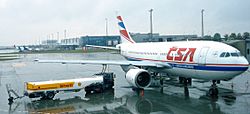Jet fuel facts for kids
Quick facts for kids Jet fuel |
|
|---|---|
 |
|
| Properties | |
| Molecular formula | |
| Molar mass | 0 g mol-1 |
| Appearance | Straw-colored liquid |
| Density | 775.0-840.0 g/L |
| Melting point | |
| Boiling point | |
| Except where noted otherwise, data are given for materials in their standard state (at 25 °C, 100 kPa) | |
Jet fuel, also called aviation turbine fuel (ATF), is a special type of aviation fuel used in aircraft that have jet engines. It can be clear or look like a light straw color.
Jet fuel is made up of many different hydrocarbons. These are chemical compounds made from hydrogen and carbon. The exact mix of these hydrocarbons is carefully chosen to make sure the fuel works well in different conditions, like very cold weather.
Contents
What is Jet Fuel?
Jet fuel is the power source for most modern airplanes. It's different from the gasoline used in cars because jet engines work in a different way. Instead of sparking fuel to make an explosion, jet engines burn fuel continuously to create a powerful thrust.
Types of Jet Fuel
The most common types of jet fuel used for regular flights are called Jet A and Jet A-1. These fuels meet strict international rules to make sure they are safe and work everywhere.
Another type, Jet B, is used less often. It's special because it works better in very cold places. This is important for planes flying in extremely cold regions or at high altitudes where temperatures drop very low.
How Jet Fuel is Made and Used
Jet fuel is made from petroleum, just like gasoline and diesel. It goes through a special process at oil refineries to become the right kind of fuel for aircraft.
After it's made, the fuel is stored and transported carefully to airports. When a plane needs to fly, special trucks pump the jet fuel into its tanks. This process is called refueling.
Global Use of Jet Fuel
The amount of jet fuel used around the world has grown a lot over the years. Since 1980, the daily use of jet fuel has more than tripled. This shows how much air travel has increased globally. For example, in 2010, about 5.2 million barrels of jet fuel were used every day! A large part of this fuel is used in the United States.
Images for kids
-
Shell Jet A-1 refueller truck on the ramp at Vancouver International Airport. Note the signs indicating UN1863 hazardous material and JET A-1.
-
A US Airways Boeing 757 being fueled at Fort Lauderdale–Hollywood International Airport
-
An Iberia Airbus A340 being fueled at La Aurora International Airport
See also
 In Spanish: Combustible de turbina de aviación para niños
In Spanish: Combustible de turbina de aviación para niños





